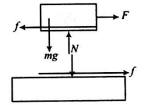- Tardigrade
- Question
- Physics
- A large slab of mass 5 kg lies on a smooth horizontal surface, with a block of mass 4 kg lying on the top of it. The coefficient of friction between the block and the slab is 0.25. If the block is pulled horizontally by a force of F=6 N, the work done by the force of friction on the slab, between the instants t=2 s and t=3 s, is (g=10 m s -2)
Q.
A large slab of mass $5\, kg$ lies on a smooth horizontal surface, with a block of mass $4\, kg$ lying on the top of it. The coefficient of friction between the block and the slab is $0.25$. If the block is pulled horizontally by a force of $F=6\, N$, the work done by the force of friction on the slab, between the instants $t=2\, s$ and $t=3\, s$, is $\left(g=10\, m s ^{-2}\right)$
Work, Energy and Power
Report Error
Solution:

Maximum frictional force between the slab and the block
$f_{\max } =\mu N=\mu m g$
$=\frac{1}{4} \times 4 \times 10=10\, N$
Evidently, $f < f_{\max }$
So, the two bodies will move together as a single unit. If $a$ be their combined acceleration, then
$a=\frac{F}{m+M}=\frac{6}{4+5}=\frac{2}{3} m s ^{-1}$
Therefore, frictional force acting can be obtained as
$f=M a=\frac{2}{3} \times 5 N =\frac{10}{3} N$
Using $s=\frac{1}{2} a t^{2}$
$s(2)=\frac{1}{2} \times \frac{2}{3}(2)^{2}=\frac{4}{3} $ and $ s(3)=\frac{1}{2} \times \frac{2}{3}(3)^{2}=3$
Therefore, work done by friction $=f[s(3)-s(2)]$
$=\frac{10}{3}\left[3-\frac{4}{3}\right]=\frac{50}{9}=5.55\, J$
Questions from Work, Energy and Power
Physics Most Viewed Questions
1. If $E$ and $G$ respectively denote energy and gravitational constant, then $\frac{ E }{ G }$ has the dimensions of:
NEET 2021
Physical World, Units and Measurements
2. The de Broglie wavelength of an electron moving with kinetic energy of $144 \,eV$ is nearly
NEET 2020
Dual Nature of Radiation and Matter
3. A car starts from rest and accelerates at $5\, m / s ^{2}$ At $t=4\, s$, a ball is dropped out of a window by a person sitting in the car. What is the velocity and acceleration of the ball at $t =6\, s$ ? (Take $\left. g =10\, m / s ^{2}\right)$
NEET 2021
Motion in a Straight Line
Latest Updates
- JEE Main 2023 February 25th Shift 1 Morning
- JEE Main 2023 February 25th Shift 2 Evening
- JEE Main 2023 January 31st Shift 1 Morning
- JEE Main 2023 January 31st Shift 2 Evening
- JEE Main 2023 January 30th Shift 1 Morning
- JEE Main 2023 January 30th Shift 2 Evening
- JEE Main 2023 January 25th Shift 1 Morning
- JEE Main 2023 January 25th Shift 2 Evening
- JEE Main 2023 January 24th Shift 1 Morning
- JEE Main 2023 January 24th Shift 2 Evening
- JEE Main 2023 February 1st Shift 1 Morning
- JEE Main 2023 February 1st Shift 2 Evening
- JEE Main 2022 July 25th Shift 1 Morning
- JEE Main 2022 July 25th Shift 2 Evening
- JEE Main 2022 July 26th Shift 1 Morning
- JEE Main 2022 July 28th Shift 1 Morning
- JEE Advanced 2022 Paper 2
- JEE Advanced 2022 Paper 1
- JEE Advanced 2021 Paper 2
- JEE Advanced 2021 Paper 1
- JEE Advanced 2020 Paper 2
- JEE Advanced 2020 Paper 1
- NEET 2022 Physics Answer Key
- NEET 2022 Chemistry Answer Key
- NEET 2022 Botany Biology Answer Key
- NEET 2022 Zoology Biology Answer Key
- NEET Rank Predictor 2023